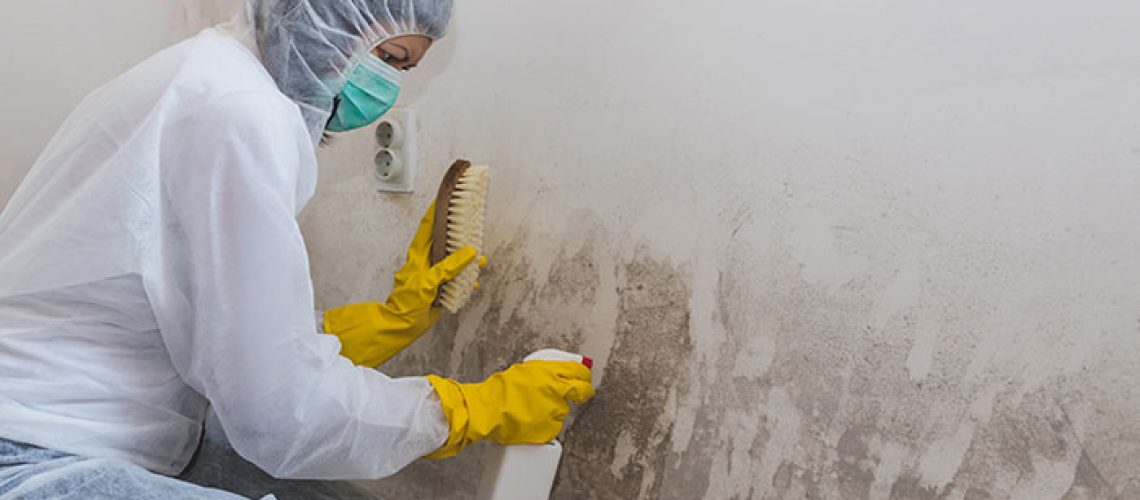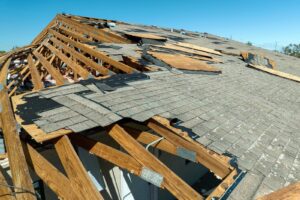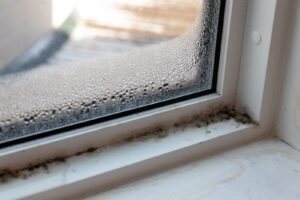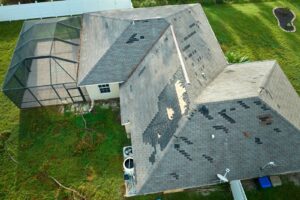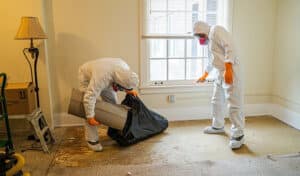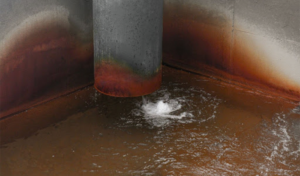Mold-killing paint might seem like a simple solution to treating growth on your walls, but does it really work? The idea of simply painting over a mildewy mess sure sounds appealing. It’ll look good as new, right? Not necessarily.
Here’s everything you need to know about paint that claims to kill, block, and resist mold.
Mold Growth in Walls
It’s important to examine how spores grow in the drywall in order to fully understand how paint for mold works.
Mold growth requires a few things: food, water, and oxygen. Porous materials like drywall are an ideal breeding ground for spores because it provides easy-to-access food and plenty of room to grow. But that doesn’t mean that mold is just going to start growing if your home is clean and dry. There’s still a missing ingredient: moisture.
The most common cause of mildewy walls is a water leak or flood that doesn’t get addressed immediately. Houses in highly humid areas can also get mold in their walls because the air has so much moisture in it. The key to preventing spores from growing is to keep everything as dry as possible and dry it out quickly if a flood or a leak does occur.
The Myth of Mold-killing Paint
Imagine you come home from a trip and find that your basement had a leak. The walls are moldy with dark, ugly stains and a dank, mildewy smell. You’ll do anything to get rid of that eyesore, so you walk into a home improvement store in search of solutions. That’s when you find it: mold-killing paint. It’s the perfect product and will surely solve all of your problems.
The paint-center employees help you color match your paint, and then you head home with an armful of supplies prepared to tackle your disaster of a wall. You paint a fresh coat and wait for it to dry. The difference is astounding. Your moldy wall problem is gone! Or is it?
After a few days, you notice that the mildewy smell is still there. Weeks pass and then that beautiful fresh layer of paint starts bubbling. It’s getting worse with time. What’s going on? Did you do something wrong? Let’s take a closer look at what went wrong in this scenario.
How To Use Mold-Killing Paint
All paint for mold is not created equal. Some products may be registered as fungicidal protectants with the EPA. Others may simply block the mold from growing on the new paint surface, but won’t actually do anything to kill existing spores.
Even the most powerful mold-killing paints require two important steps for them to work properly: repairing moisture problems and pre-cleaning the walls. Either of these two steps may have been ignored in the above scenario, leading to the bubbling paint and mildewy smell.
Here’s a step-by-step look at how to use paint for mold so that it actually works and you’re not left with mold that continues to grow and bubble underneath a fresh layer of paint:
- Repairing moisture problems is the first important step to complete before using any mold-killing paint. There’s no sense in trying to kill the mold if moisture is still present because the situation will only continue to get worse. Repairing the problem involves drying the area out thoroughly after a flood, repairing any leaks, and drying the area fully.
- Pre-cleaning the walls is the next essential step once the area is thoroughly dried out. The most effective method to pre-clean your walls is to make a bleach solution using one cup of bleach for every five cups of water. Mix the bleach/water solution in a clean spray bottle and spray the affected areas of the wall thoroughly. Scrub with a bristled brush and repeat until the mold is no longer visible.
- Double-check that everything is clean and dry before you start the paint job. Cleaning may damage some of the drywall, so you should replace or repair any sections of drywall that need it before you paint.
- Paint the area with a mold-killing primer that is registered with the EPA to kill mold and fungus. Allow the primer to fully dry before applying a second coat or a coat of paint. Follow the label instructions specific to the product you’re using.
Seek Professional Help
DIY mold removal is labor-intensive and doesn’t always work. That’s why calling a professional mold remediation team is the best course of action. Mold can grow quickly and without the proper treatment, a small issue can easily become a major disaster.
Mold-killing paint might seem like an easy solution to a moldy wall, but it needs to be used with great caution and expertise. Even then, there’s no way to know that your mold problem is fully remedied because it’s been covered by paint. Seeking help from a professional is the most effective way to remedy a mold problem.
The professional team will help you repair the moisture problem, clean your walls, and restore your home or business back to its original condition. They’ll even help you work with your homeowner’s insurance to help pay for the damage repair.
Restoremasters Is Your Mold Remediation Specialist
Mold-killing paint might not be the answer to all of your problems, but Restoremasters is here to help. Our mold remediation team is equipped with the knowledge and tools to restore your home or business to its mold-free state.
Our goal at Restoremasters is to promptly repair damage to your property caused by wind, fire, mold, water, sewage, graffiti, or smoke. We have more than 100 years of combined experience in the industry and the right tools for the job, so we can get you back to everyday life regardless of the damage your home has suffered.
We are located in Sandy, Utah, and provide services across the Salt Lake and Utah County areas, from Salt Lake City to Spanish Fork and everywhere in between. Contact us today via the form on our website or call our team at 801.938.8654 to get started!

